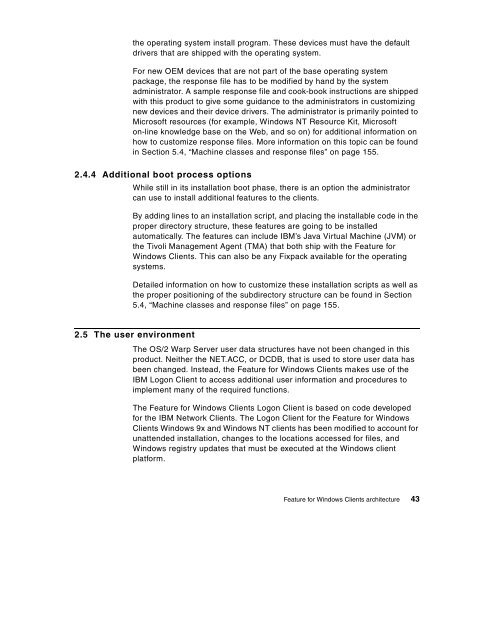WorkSpace On-Demand 2.0 Feature for Windows ... - IBM Redbooks
WorkSpace On-Demand 2.0 Feature for Windows ... - IBM Redbooks
WorkSpace On-Demand 2.0 Feature for Windows ... - IBM Redbooks
Create successful ePaper yourself
Turn your PDF publications into a flip-book with our unique Google optimized e-Paper software.
the operating system install program. These devices must have the default<br />
drivers that are shipped with the operating system.<br />
For new OEM devices that are not part of the base operating system<br />
package, the response file has to be modified by hand by the system<br />
administrator. A sample response file and cook-book instructions are shipped<br />
with this product to give some guidance to the administrators in customizing<br />
new devices and their device drivers. The administrator is primarily pointed to<br />
Microsoft resources (<strong>for</strong> example, <strong>Windows</strong> NT Resource Kit, Microsoft<br />
on-line knowledge base on the Web, and so on) <strong>for</strong> additional in<strong>for</strong>mation on<br />
how to customize response files. More in<strong>for</strong>mation on this topic can be found<br />
in Section 5.4, “Machine classes and response files” on page 155.<br />
2.4.4 Additional boot process options<br />
While still in its installation boot phase, there is an option the administrator<br />
can use to install additional features to the clients.<br />
By adding lines to an installation script, and placing the installable code in the<br />
proper directory structure, these features are going to be installed<br />
automatically. The features can include <strong>IBM</strong>’s Java Virtual Machine (JVM) or<br />
the Tivoli Management Agent (TMA) that both ship with the <strong>Feature</strong> <strong>for</strong><br />
<strong>Windows</strong> Clients. This can also be any Fixpack available <strong>for</strong> the operating<br />
systems.<br />
Detailed in<strong>for</strong>mation on how to customize these installation scripts as well as<br />
the proper positioning of the subdirectory structure can be found in Section<br />
5.4, “Machine classes and response files” on page 155.<br />
2.5 The user environment<br />
The OS/2 Warp Server user data structures have not been changed in this<br />
product. Neither the NET.ACC, or DCDB, that is used to store user data has<br />
been changed. Instead, the <strong>Feature</strong> <strong>for</strong> <strong>Windows</strong> Clients makes use of the<br />
<strong>IBM</strong> Logon Client to access additional user in<strong>for</strong>mation and procedures to<br />
implement many of the required functions.<br />
The <strong>Feature</strong> <strong>for</strong> <strong>Windows</strong> Clients Logon Client is based on code developed<br />
<strong>for</strong> the <strong>IBM</strong> Network Clients. The Logon Client <strong>for</strong> the <strong>Feature</strong> <strong>for</strong> <strong>Windows</strong><br />
Clients <strong>Windows</strong> 9x and <strong>Windows</strong> NT clients has been modified to account <strong>for</strong><br />
unattended installation, changes to the locations accessed <strong>for</strong> files, and<br />
<strong>Windows</strong> registry updates that must be executed at the <strong>Windows</strong> client<br />
plat<strong>for</strong>m.<br />
<strong>Feature</strong> <strong>for</strong> <strong>Windows</strong> Clients architecture 43

















